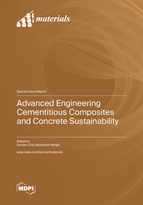Advanced Engineering Cementitious Composites and Concrete Sustainability
A special issue of Materials (ISSN 1996-1944). This special issue belongs to the section "Construction and Building Materials".
Deadline for manuscript submissions: closed (10 January 2023) | Viewed by 44380
Special Issue Editor
Interests: engineering cementitious composites; concrete; geopolymers; concrete sustainability; concrete durability; alkali activated materials; materials science; materials chemistry; concrete material technology
Special Issues, Collections and Topics in MDPI journals
Special Issue Information
Dear Colleagues,
One of the most used building materials today, concrete, is the base of modern constructions around the world, being used for foundations, pavements, building walls, architectural structures, roads, bridges, overpasses, etc. Due to its versatility, it can be stated that almost all buildings include concrete in one form or another. However, the diversified nature of the components, their combination, and dosage lead to a very wide range of types of concrete, with different characteristics. Therefore, concrete is a material in continuous development that is of high interest even today.
Currently, to reduce or eliminate the limitations of this material, which are related to its brittleness and negative impact on the environment, alternative methods of its manufacture have been sought. Therefore, the development of engineering cementitious composites has led to a significant reduction in flexibility issues, while the introduction of new additives or the optimization of the manufacturing process have led to a significant decrease in the negative effects of the exploitation of virgin raw materials. However, in-depth studies are still needed to optimize and improve the sustainability of these advanced engineering cementitious composites or alternative concrete.
Therefore, the main objectives of this Special Issue include modeling and obtaining new advanced cementitious materials or alternative concrete.
Areas of interest include but are not limited to:
- Advanced engineering cementitious composites;
- Modeling and simulation of concrete;
- Characterization of sustainable cementitious materials;
- Sustainable concrete and alternative cementitious binders;
- Additive manufacturing of concrete;
- Sustainability and environmental impact assessment of concrete materials;
- Geopolymer obtaining and characterization;
- Alkali-activated materials.
Dr. Dumitru Doru Burduhos Nergis
Guest Editor
Manuscript Submission Information
Manuscripts should be submitted online at www.mdpi.com by registering and logging in to this website. Once you are registered, click here to go to the submission form. Manuscripts can be submitted until the deadline. All submissions that pass pre-check are peer-reviewed. Accepted papers will be published continuously in the journal (as soon as accepted) and will be listed together on the special issue website. Research articles, review articles as well as short communications are invited. For planned papers, a title and short abstract (about 100 words) can be sent to the Editorial Office for announcement on this website.
Submitted manuscripts should not have been published previously, nor be under consideration for publication elsewhere (except conference proceedings papers). All manuscripts are thoroughly refereed through a single-blind peer-review process. A guide for authors and other relevant information for submission of manuscripts is available on the Instructions for Authors page. Materials is an international peer-reviewed open access semimonthly journal published by MDPI.
Please visit the Instructions for Authors page before submitting a manuscript. The Article Processing Charge (APC) for publication in this open access journal is 2600 CHF (Swiss Francs). Submitted papers should be well formatted and use good English. Authors may use MDPI's English editing service prior to publication or during author revisions.
Keywords
- cement
- alternative cementitious materials
- geopolymers
- sustainable development
- self-healing materials
- construction materials
- durability
- eco-efficient concrete
- life cycle analysis
- functional properties







